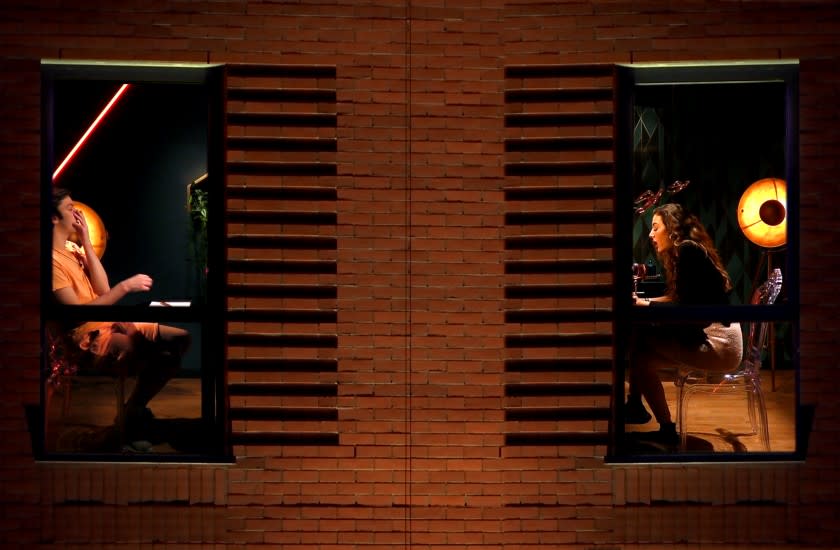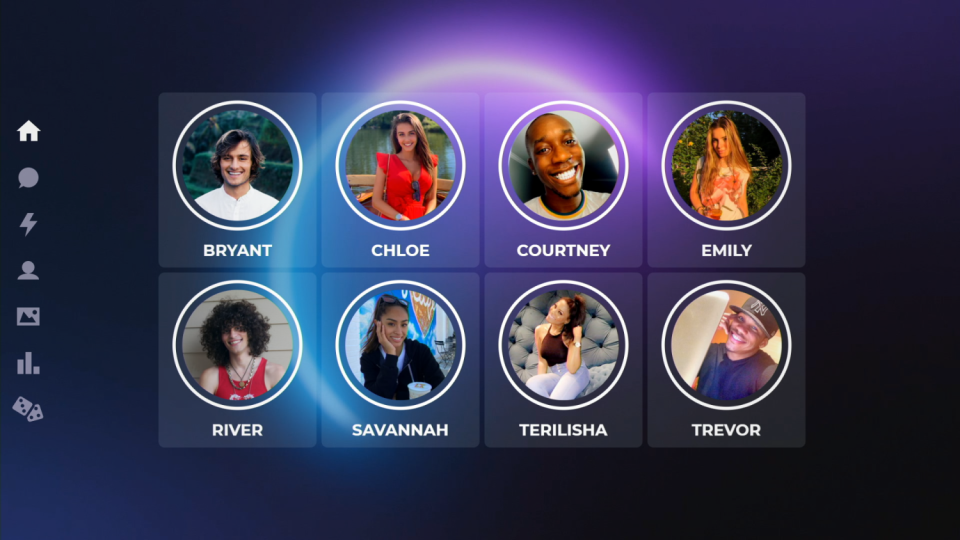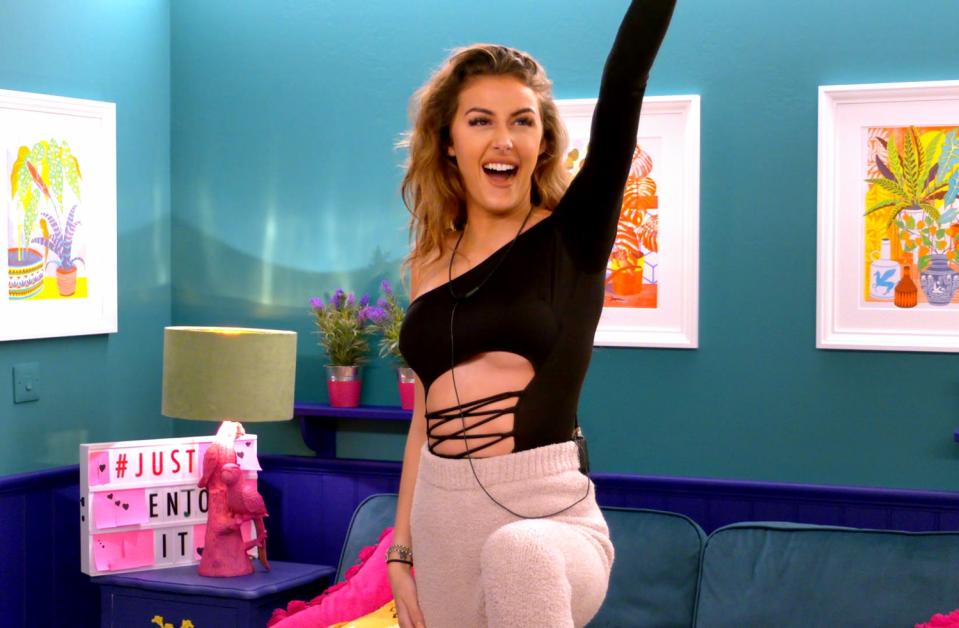Netflix's reality sensation 'The Circle' is back. And this time, it's cutthroat

Last January, before the world went into lockdown, Netflix premiered its hybrid social experiment/reality TV show “The Circle.” Little did the streaming service know that the “Catfish”-meets-“Big Brother” competition — the first of several reality sensations it released in 2020, including “Love Is Blind” and “Too Hot to Handle” — would turn out to be a prescient glimpse of our technology-dependent pandemic year.
In “The Circle,” contestants never meet face to face. Instead, they’re connected only through their social media personas — some of which are real, some exaggerated and some fake. While quarantined in separate apartments, where no-contact drop-offs were the norm before the pandemic made them a health and safety issue, eight strangers aim to be “influencers.” Aside from their “Circle”-tailored, carefully curated social media profiles, members remain anonymous and can only communicate through a social media app that transcribes their messages. What comes next begins with bonding, though drama is never far behind. At the end of the day, says executive producer Tim Harcourt, “The Circle” “is a game of communication”: “The best communicator wins.”
After all, it is a competition, and contestants periodically rate one another. The two top-rated players, or “influencers,” determine one or more players that will be “blocked” — kicked out of “The Circle” and denied the chance to win $100,000. Departing participants get a final word, in the form of a visit with the Circle member of their choice and a video message to the group, which may well reveal that their persona was a ruse all along. But this isn’t exactly an elimination game: The blocked player is replaced with new contestants.
Heading into Season 2, though, "The Circle" has some new tricks up its sleeve. Here’s how the series plans to keep contestants — and fans — on the edge of their seats.

Strategy has replaced authenticity.
Even with a pair of catfishes in the mix to pull the wool over their fellow contestants’ eyes, there was a surprising amount of heart in the inaugural season: eventual winner Joey Sasso, who could have been a cast member of “Jersey Shore,” took home the top prize for his big heart and sense of loyalty.
But in Season 2, the competition is more cutthroat, and the relationship-building more performative. “I was expecting people to come and be a bit more strategic, but I was surprised at how strategic it was and how quickly it got strategic,” says Harcourt. “I feel like the characters are still authentic and still have genuine bonds, but at the back of their mind is winning and the money.”
And it makes for great TV. They lie, flirt and ally their way to get there. Off the bat, one contestant declares themselves ready to be the “villain” of “The Circle” to get the money; another assumes her husband’s persona — and makes him a hot single dad — in hopes of catfishing her way to the house she always wanted for her family.
“Just because you like someone doesn't mean you owe them anything in a game for $100,000, so you shouldn't be scared to employ tactics to get ahead,” says Season 2 contestant Jack. Likewise, fellow player Lisa went in intending “to be nice to everyone,” she says, but “when you’re playing the game, it goes out the window a little bit because you’re seeing how other people are playing.”
Season 2 stepped up its casting game.
While the first season saw just one middle-aged player, Season 2 keeps things from becoming stale by adding in a few more, well, seasoned players. One, Lee, is a 58-year-old author who has spent his career writing books under a female pen name — and, with his IRL catfishing experience, he enters the game as a 20-year-old free spirit named “River.” There’s also a foil to Season 1 favorite Shubham, who stole the hearts of players and viewers alike, in the form of eccentric breathwork expert Bryant, whose unwavering optimism is either endearing or unsettling, depending on your perspective.
But there are more juicy twists embedded in the show’s Season 2 casting. This time around, there’s a layer of “celebrity” to the mix: Chloe, of “Too Hot to Handle” fame, “had us all in hysterics” on the Netflix dating show, explains Harcourt, “so we discussed the idea of trying to see if she'd be interested in entering. And actually she had to enter like a normal contestant with a chance of winning.”
Then there’s the surprising addition of Lance Bass — sort of. “[Lance] really wanted me to apply, too, because he doesn’t have the time to devote to playing those things, so he was like, ‘You’re the next best thing,’” says Lisa, the NSYNC member’s real-life personal assistant, who imitates the former boy bander this season. (Two decades since the group said “Bye Bye Bye,” some younger players thought of Bass as just another anonymous contestant: “I was like, ‘Who the f— is 'Lance B-a-s-e?’ Is he a DJ?’”
“I don't think we actually set out to find this celebrity or somebody who worked for a celebrity, so that landed on our laps,” Harcourt says.

"The Circle" was a perfect primer for life during COVID-19.
In “The Circle,” contestants spend the majority of their time on the couch in front of a screen. And since face-to-face meetings aren’t permitted, parties for one are the norm, with no-contact pizza, props and even a speaker that blasts the same song into every member’s apartment. Before COVID, it might have been hard to believe that players who were completely isolated aside from their digital relationships were actually having fun. But the Netflix series was eerily prophetic: Add in Zoom, and “The Circle” looked a lot like life in the pandemic. “It’s gone from being a slightly dystopian, far-flung, crazy experiment to a game based on a similar premise to how we've lived our lives,” says Harcourt.
Of course, “The Circle” already had the forms of communication that have defined the pandemic in its DNA: Participants could only speak via chat rooms and DMs, and IRL meetings were a no-go. As the way the world socialized was turned upside down in the last year, life imitated reality TV: “[‘The Circle’] is a moment to reflect on how difficult it is to communicate when you're not in the same room as a person, where you can pick up on their tells and their body language, and all those things that we take for granted and lose over conference calls and Zoom,” says Harcourt.
Still, “The Circle” has mirrored the way social media provides deeper connections when meeting in-person isn’t possible. Contestants in Season 1, for instance, shared their personal family traumas and their insecurities, as well as heartwarming moments. In the second season, that continues with a confession from Bryant that he previously struggled with his mental health and bulimia. If “The Circle” emerged as a deeper look at the human experience because of COVID, though, that doesn’t mean it’s suddenly serious: It’s still reality TV escapism, mixing hot people, relationship drama and social media. What more can you ask for?
This story originally appeared in Los Angeles Times.

